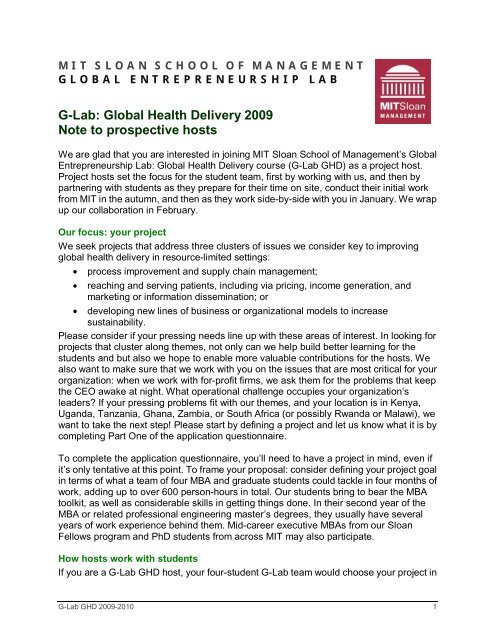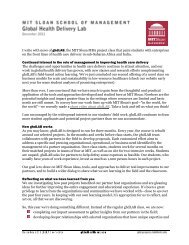G-Lab - global health at MIT
G-Lab - global health at MIT
G-Lab - global health at MIT
Create successful ePaper yourself
Turn your PDF publications into a flip-book with our unique Google optimized e-Paper software.
September and confirm the scope, schedule and deliverables with you in October. Theteam undertakes significant background research or a rel<strong>at</strong>ed study th<strong>at</strong> makes the mostof <strong>MIT</strong>’s resources while continuing to refine and plan their work, with faculty guidance, oncampus from October to December. They then work on-site <strong>at</strong> your organiz<strong>at</strong>ion in Africafor <strong>at</strong> least three weeks in January 2010. Your student team will formally present itsconclusions to you <strong>at</strong> the end of this internship, and also provide additional written reports,d<strong>at</strong>a, and other m<strong>at</strong>erials and resources th<strong>at</strong> you agree upon.Students are not compens<strong>at</strong>ed for their work. This is a learning experience for them. Wework to raise funds to cover airfares and as much of the housing costs as we can, but wedo ask host organiz<strong>at</strong>ions to pay for any portion of these expenses th<strong>at</strong> is feasible. (G-<strong>Lab</strong>GHD is a new version of a decade-old class th<strong>at</strong> has served entrepreneurs in manycountries. For most of the several hundred projects to d<strong>at</strong>e, host businesses coveredairfares, travel and housing expenses.)We expect host organiz<strong>at</strong>ions to help arrange local accommod<strong>at</strong>ions for the student teamand assist with other local arrangements as needed. Apart from wh<strong>at</strong> is entailed in theon-site work itself (e.g. local transport to clinics for interviews or transl<strong>at</strong>ors if needed),here are no additional costs involved for host organiz<strong>at</strong>ions.Meet the teamYour point of entry is the applic<strong>at</strong>ion and project scoping process th<strong>at</strong> the G-<strong>Lab</strong> GHDteam works on from May to September. Our team includes a variety of faculty besides theG-<strong>Lab</strong> GHD instructor, <strong>MIT</strong> Sloan School of Management Senior Lecturer Anjali Sastry:you may hear from <strong>MIT</strong> Sloan’s Jon<strong>at</strong>han Lehrich or Jeff Shames; Laura Gay or ShibaNem<strong>at</strong>-Nasser may also follow up. Other collabor<strong>at</strong>ors include our colleagues <strong>at</strong> theEntrepreneurship Center. A linchpin of G-<strong>Lab</strong> GHD is our partnership with the GlobalHealth Delivery Project, which is headed by Rebecca Weintraub. She and Global HealthDelivery Project founders Jim Kim and Paul Farmer, along with G-<strong>Lab</strong> founders RichardLocke and Simon Johnson, inspired this class. And Global Health Delivery Projectcolleague Maria May is helping refine the class, find and shape projects, and constructuseful products from our learning. Also on our project recruiting team are other GHDexperts and along with some current <strong>MIT</strong> students and several recent <strong>MIT</strong> gradu<strong>at</strong>es.How we use the questionnaireWe carefully review your responses to the two-part applic<strong>at</strong>ion questionnaire to ensure agood fit between your needs and interests and the course learning goals. Eventually, yourcompleted questionnaire will be posted, along with others, on an <strong>MIT</strong> website restricted toG-<strong>Lab</strong> students. Students use this inform<strong>at</strong>ion to select their preferred projects andfaculty draw on it to gener<strong>at</strong>e the best m<strong>at</strong>ches among teams and host organiz<strong>at</strong>ions.More organiz<strong>at</strong>ions apply to particip<strong>at</strong>e in G-<strong>Lab</strong> GHD than are eventually selected bystudents. This means, alas, th<strong>at</strong> every year there are projects th<strong>at</strong> do not get taken up.Please take the time to thoughtfully describe your organiz<strong>at</strong>ion and the specific project, soth<strong>at</strong> students can fully appreci<strong>at</strong>e the opportunity.G-<strong>Lab</strong> GHD 2009-2010 2
TimelineWe suggest you complete and submit Part One of the applic<strong>at</strong>ion questionnaire assoon as is feasible so th<strong>at</strong> we can start working with you as needed to address openquestions. We expect many host organiz<strong>at</strong>ions to complete Part One in June 2009.If you provide Part One applic<strong>at</strong>ions to us by 24 July, we will give you feedback by theend of July th<strong>at</strong> may be helpful in your completion of Part Two.The entire applic<strong>at</strong>ion, including Part Two, is due by 21 August. By early September,we will let you know if your proposal is being seen by students, and by the end ofSeptember expect to m<strong>at</strong>ch teams and projects.You may submit both Parts One and Two by 21 August without submitting Part One first,but our experience shows th<strong>at</strong> the refining process between initial and final applic<strong>at</strong>ionsimproves the chance th<strong>at</strong> student teams are appropri<strong>at</strong>ely m<strong>at</strong>ched to the project.An online version of the applic<strong>at</strong>ion is expected to be available in early June viahttp://g-lab.mit.edu. You can also download the form fromhttp://<strong>global</strong><strong>health</strong>.mit.edu/glab-ghd/. We prefer online submissions, but if online entry isunavailable, you may send us a document containing your questionnaire answers.If you have any questions or need clarific<strong>at</strong>ions, please contact us by email <strong>at</strong>glab.ghd@gmail.com. You may also find more inform<strong>at</strong>ion <strong>at</strong> the G-<strong>Lab</strong> website –http://g-lab.mit.edu – which we expect to be upd<strong>at</strong>ed by early June. To learn more aboutG-<strong>Lab</strong> GHD’s experience last year, please visit http://<strong>global</strong><strong>health</strong>.mit.edu/glab-ghd/.Many thanks for your interest. We look forward to hearing from you and are very glad tohave the opportunity to work in this important area.Sincerely,Anjali SastryJon<strong>at</strong>han LehrichJeff Shames<strong>MIT</strong> Sloan School of ManagementRebecca WeintraubMaria MayGlobal Health Delivery Project,Harvard Medical SchoolP.S. Some of us, including several volunteers, expect to travel this summer. Please drop us a lineif you’re in any of these loc<strong>at</strong>ions—we’d love to work together in person. The July and Augustd<strong>at</strong>es are still tent<strong>at</strong>ive.Cape Town, June 7-10 and June 13-16Windhoek, June 10-13Nairobi, June 9-14Dar es Salaam, June 15-22Kampala, June 22-26Accra/elsewhere in Ghana, JulyKigali, JulyLusaka, July or AugustDurban, JulyG-<strong>Lab</strong> GHD 2009-2010 3



